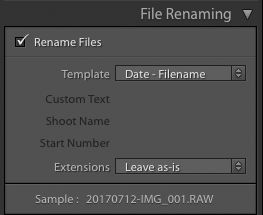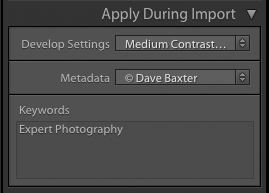[ExpertPhotography is supported by readers. Product links on ExpertPhotography are referral links. If you use one of these and buy something, we make a little bit of money. Need more info? See how it all works here.]
Importing Photos Into Lightroom: What is Importing?
You may have heard people talking about ‘importing photos into Lightroom’ as if they’re somehow adding the images themselves to Lightroom. This is not actually the case. In essence, importing your photos boils down to telling Lightroom where they are in your storage. The location of your photos and camera-generated EXIF data (shutter speed, aperture, time and date, etc.) are all entered into Lightroom’s catalog. It’s rather like filling in an old style index card for a new book in a library. You cannot edit any photos in Lightroom until you’ve first imported them. This is done from the Library Module. Check that the Library Module has been selected in the top module selection strip. If you can’t see it, click the little arrow at the top center. It should look like this: On the left-hand side of the screen, you should see a pane containing several other panels and, at the bottom of this, you should see the ‘Import’ button. If this pane is not visible, just tap the TAB key and it should appear as follows:
Importing from a Camera
To import pictures from your camera, connect it to your computer using a USB cable (there’s no need to use a card reader or other special software). Switch the camera on and click the Import button to bring up the import dialogue box: The layout of this dialogue box is very logical—you just adjust the settings in the windows from left to right and then hit the Import button.
The Left Window
This shows you the various places from which you can import photos. It will show all connected hard drives, memory cards and cameras. Your camera should appear in the list (it may show up with as your camera’s model name or it may just be called ‘NO NAME’). Click the item corresponding to your camera and you should see the thumbnails begin to appear in the center window, which is the main part of the screen.
The Centre Window
The images stored on your camera will appear as thumbnails in the main area of the screen. Untick any that you don’t want to import. If any photos appear greyed out, this indicates that Lightroom thinks you’ve already imported them. The selection at the top center of this screen is very important. Lightroom will normally select the correct option; this doesn’t always happen, so it pays to check this. There are four options: ‘Copy as DNG’, ‘Copy’, ‘Move’ and ‘Add’. When importing images into Lightroom from a camera’s media card, you need to copy the photos to your computer’s hard drive so that you can reuse your memory card.
‘Copy’ will copy each of the selected images as-is ‘Copy as DNG’ will convert any RAW files it finds on the card into the Adobe Digital Negative format, and then save them. This takes a little longer but it’s a good format to use for archival purposes and it takes slightly less hard drive space.
The ‘Move’ and ‘Add’ options should not be available but they can sometimes be—just check that ‘Add’ has not been selected otherwise you will not be able to edit the photos later.
The Right Window
The destination to which your photos will be copied is displayed just above this panel. This can be any drive, either the computer’s own internal hard drive or an external USB drive. Many people choose to have a general purpose folder on their chosen drive to which they import all their images. Select the destination folder by clicking the top right area to see a list of recent destinations or click on a folder from the Destination panel at the bottom of the window. If you want to create a new folder to which the photos will be copied, click the ‘+’ button at the very top of the Destination panel. Some people find that after importing photos into Lightroom they have loads of unwanted sub-folders named by date, with only a few photos in each one. This is because the ‘Organize’ drop-down box in the Destination panel was set to ‘By Date’ instead of ‘Into one folder’ as shown above. If you want to place your photos into a new subfolder, you can tick the ‘Into Subfolder’ box and supply a suitable name.
Import Options
Lightroom allows you to perform a number of useful tasks. You can apply these as photos are copied to your computer and added to the catalog.
File Handling
Options for how each imported file is handled are listed in the ‘File Handling’ window. Here’s a rundown of what each of these options do:
Build Previews
In order to display thumbnail photos in the various Lightroom modules, it’s necessary to build previews of each photo. This happens during the import process. You can use the drop-down box in this panel to choose from three types of previews (other than the Standard preview). These previews differ by quality and are as follows:
Standard – This is the default preview. Standard uses the Camera Raw engine for processing and so sometimes appear different from minimal or embedded previews. Minimal – This preview produces low resolution camera-generated JPEG images that are very fast to create but not color managed. Embedded & Sidecar – These are larger camera-generated previews that take a little longer to create than minimal previews. 1:1 – These are full-sized images that Lightroom uses when you zoom into an image. When you tell Lightroom to generate 1:1 previews, it also generates minimal and standard previews, so that all three are available as the software requires. Full-sized previews can take a long time to generate and make the import process very slow.
Build Smart Previews
If you have your master photos always available to the catalog, you can leave the ‘Build Smart Previews’ box unticked. If you want to edit your photos when the master images are not online (when the external USB drive on which they reside has been unplugged, for example), Smart Previews allow you to make edits with missing master photos. But if you don’t intend to do this, leave the box unticked. Smart Previews will take up extra space on your hard drive. You can make a Smart Preview easily later on if you need to.
Don’t Import Suspected Duplicates
Sometimes photos are left on a media card between import sessions, from one shoot to the next. This can make it difficult since some photos on the card will be new and some will have already been imported to Lightroom. In cases like this, it’s possible that the same photo will be copied to more than one place on your hard drive, which ends up getting messy when importing. To help avoid this happening, tick the ‘Don’t Import Suspected Duplicate’ box. Lightroom will then check the EXIF data for each photo against those it already knows about and grey out any it thinks you already have in the catalog. Ideally, you should import all the images on a card, and once safely copied to your hard drive, the media card should be re-formatted ready for the next shoot. However, not everyone does this, based on personal preference and habit. So even if you always reformat your cards, it’s generally a good idea to tick this box as it will help keep things tidy.
Make a Second Copy To:
You don’t want random duplicates of some of your photos, but you should have comprehensive back-ups. All hard drives will fail eventually so having access to a copy of each photo is a good insurance against accidental deletion or hardware failure. The best system is to have a proper incremental back-up procedure in place using proprietary backup software. However, if you don’t enjoy this level of protection, Lightroom does offer some kind of solution. If you tick the ‘Make a Second Copy To:’ box, you can specify another hard drive folder to which Lightroom will copy your photos during import. This saves you from remembering to back up your photos but it doesn’t allow you to rename any photos during the process. It’s just a direct copy of what happened to be on the camera’s media card—crude but better than nothing.
Add to Collection
If you tick this box, Lightroom can automatically add all the photos you’re importing then to an existing collection.
File Renaming
If you’re trying to import photos from several different cameras, you’ll quickly discover that the chances of having two or more photos with the same file name is quite high. Because of this, it’s useful to be able to rename the rather cryptic file names your camera generates to more recognisable and unique names. To do this, just tick the ‘Rename Files’ box and select a template from the drop-down box. In the example above, the template chosen adds the date to the front of the filename provided by the camera. If you’re using several cameras on the same shoot, you might instead want to select a template that includes a custom name for a particular camera. There are lots from which to choose but if nothing suits your way of working, you can opt to make your own template by selecting ‘Edit’.
Apply During Import
This import option allows you to add additional information (metadata) to your photo files. A handy tip is to use the ‘Apply During Import’ panel to add a copyright in the metadata for each image imported. If you’ve already found some develop adjustments you like and you’ve saved them as a preset, select this or any other preset from the Develop Settings drop-down box. Lightroom will then apply those settings to each imported photo. This panel also allows you to add keywords to help you with the task of organizing photos in Lightroom.
Save Your Import Settings
Finally, at the bottom of the import screen, there’s an option to save your import settings as a named preset—just click on the arrows and select ‘Save Current Settings as New Preset…’
How to Import From A Hard Drive
Importing from a hard drive is simple. Lightroom only needs to know where the photos are already located. There is no need to copy or rename them, but it’s all too easy to make accidental copies if you don’t carefully watch the settings. Follow these steps when importing from a hard drive:












